http://www.freepressjournal.in/analysis/rn-bhaskar-maharashtra-opens-up-its-hinterland/1110674
Unlocking Maharashtra’s wealth
— By | Jul 27, 2017 07:23 am
In many ways one could draw parallels between India’s Golden Quadilateral (GQ) and Maharashtra’s biggest roadway project. Christened as the Nagpur-Mumbai Expressway (NMEW) or the Samruddhi Mahamarg, this 701 km highway could actually transform the state like no other project has during the past five decades.
To understand the dramatic change the GQ made to India, one must first bear in mind that during the previous six decades since independence, the government had built just 334 miles (537.521 km) of 4-lane roads. True, it had refurbished and maintained the vast network of roads that had been built by the British and the erstwhile kingdoms. Yes, it had also built rural roads. But it had not embarked on any major roadway that could improve connectivity within India.
 Then, came in the Vajpayee government. It saw highways as the one major activity that could transform the country. It would, as in the US during the Great Depression, catalyse growth and create jobs. In just four years, the Vajpayee government had finished building almost 98% of the 3,625 km 4-6 lane highway connecting Delhi, Mumbai, Chennai and Kolkata (hence it was called the Golden Quadilateral). It ran through 13 states and 17 cities (with a million or more inhabitants). And it provided access to tens of thousands of villages and towns. In fact, much of the economic boom that the next government took credit for was directly because of this GQ project.
Then, came in the Vajpayee government. It saw highways as the one major activity that could transform the country. It would, as in the US during the Great Depression, catalyse growth and create jobs. In just four years, the Vajpayee government had finished building almost 98% of the 3,625 km 4-6 lane highway connecting Delhi, Mumbai, Chennai and Kolkata (hence it was called the Golden Quadilateral). It ran through 13 states and 17 cities (with a million or more inhabitants). And it provided access to tens of thousands of villages and towns. In fact, much of the economic boom that the next government took credit for was directly because of this GQ project.
Now Maharashtra wants to have its own major 6 lane expressway, connecting Mumbai and Nagpur. It will span a distance of 701 km. That could shrink travel time between the two cities from 18 hours to 4-6 hours. About 47.24% length of the proposed expressway will pass through cultivated land and the remaining 52.8% length traverse through forest and barren stretches. Expect agriculture to become a major beneficiary, and a significant reduction in illegal mining (http://www.asiaconverge.com/2017/04/illegal-mining-and-political-funding/). Other beneficiaries could involve steel mills, and thousands of smaller units bringing out limited quantities of their produce for want of access to larger markets.
The NMEW will pass through 10 districts from Vidarbha through Marathwada to Konkan regions. The major settlements which are set to be part of this plan are the districts of Nagpur, Wardha, Amravati, Yavatmal, Washim, Buldana, Jalna, Aurangabad, Ahmadnagar, Nasik and Thane.
Broadly, the cost will involve a total of Rs.46,000 crore. This includes an outlay of around Rs.5,500 crore for land acquisition, Rs.24,363 crore for constructing the expressway, Rs.2,500 crore for constructing new townships, Rs.768 crore towards utility shifting, Rs.218 crore towards survey and consultancy and Rs.4,485 crore towards aid packages for rehabilitation and relocation.
More significantly, like the Delhi-Mumbai Industrial Corridor (DMIC), which envisaged the setting up of 26 industrial clusters and townships, the NMEW will also plan townships along its path. “You have only two options,” says MSRDC vice-chairman and managing director, Radheshyam Mopalwar. MSRDC is the nodal agency in charge of this project. “You will have either planned townships, or unplanned ones. There is no third alternative. If we do not begin planning for townships now, we will soon have eyesores of unplanned clusters emerging on either side of the expressway.”
Hence, 18 townships along the NMEW have already been identified and planned for, though there is a possibility that this number could swell to 24. Educational hubs are also being planned in these townships, and at least 10 of them are likely to have international schools, say media reports. Typically, the biggest bang for the buck comes from town development along highways. To make a town succeed, the first expressions of interest have to come from industry, which in turn gives town planners an idea of the size of the population that the townships-cum-industrial clusters will involve.
Then begins work – simultaneously – on building the foundations for the industrial and commercial clusters, as well as identifying spots for developing social infrastructure (schools, colleges, playgrounds, hospitals and sewage treatment plants). Then begins the job of planning for internal roads and mass transport systems, and then the housing. Thus, when businesses are ready to swing into activity, employees can move in quickly, confident that the supporting social infrastructure will be in place. That is why such projects take a payback period of 25-30 years. But they also transform the economic face of the region.
These new ‘smart cities’ are likely to reduce the flood of migration of workers to cities like Mumbai and Pune. They bring in jobs, and they also add to the state’s prosperity (http://www.asiaconverge.com/2014/12/planning-for-smart-cities/).
Ideally, the road should have been accompanied with a dedicated freight corridor (DFC) as well (like the Rewari-JNPT DFC being built currently). Rail transport is half the cost of road transport. But combining road and rail could have stretched timelines enormously, hence the roadway could be considered as the first step towards Maharashtra having its own East-West connectivity.
A big beneficiary could be JNPT, which was in danger of losing a lot of traffic to Gujarat. The Rewari-JNPT DFC is expected to offload much of its cargo at (or pick up cargo from) Vadodara, which is well-connected to several ports in that state. The NMEI could create its own dynamics of trade, bring tremendous value-addition to its farms and raw materials (coal and minerals which lie in the Eastern part of the state). That could brings lots of business for JNPT.
What about the railway line? Well, that is another story.





































COMMENTS